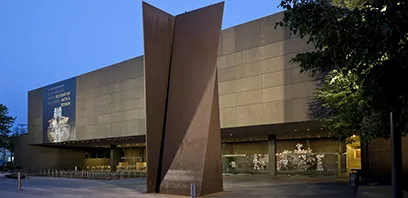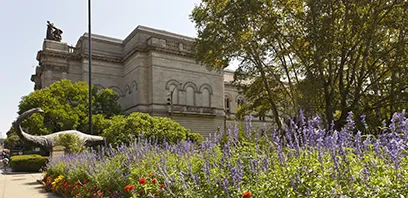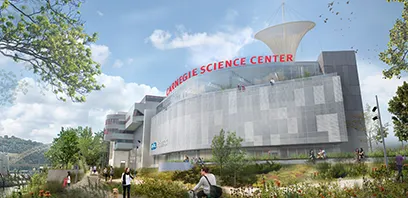by R. Jay Gangewere
Powdermill Nature Reserve tries the natural approach to fighting pollution
from abandoned mines
The fishermen stopped casting their lines into Laurel
Run more than six decades ago. The native trout were gone, and so were
the aquatic insects and smaller fish that the trout fed upon. Laurel Run
had died quietly. Like many other mountain streams in the Appalachian
Mountains, this two-mile stream at the headwaters of Loyalhanna Creek in
eastern Westmoreland County was poisoned slowly by acid and dissolved metals
seeping from a small, private coal mine hidden back in the hills.
Five or 10 years ago the acids and other contaminants draining from
abandoned mines into western Pennsylvania’s streams were thought to irreversibly
pollute the streams. “But today recent technological advances in passive
treatment systems are offering exciting new ways to improve water quality
and restore stream ecosystems,” says Lysle Sherwin of the Loyalhanna Watershed
Association (LWA). This membership-supported group is sponsoring a new
initiative to clean up Laurel Run.
Abandoned mine drainage (or AMD) is an enormous problem in Pennsylvania.
It pollutes more than 7,500 miles of streams and rivers in the United
States, and the majority of the damaged streams in the Northeast are in
western Pennsylvania and northern West Virginia. Pennsylvania alone has
more than 3,000 miles of polluted streams and rivers. Mine drainage is
the major source of stream degradation in the region, and is responsible
for 50% of the state’s streams not meeting the standards of the Clean Water
Act. It is much more damaging to streams than acid rain and agricultural
runoff.
Lysle Sherwin of the Loyalhanna Watershed and Joseph Merritt of Powdermill
Nature Reserve examine the first plants placed in the wetlands of the Friedline
project.
Bituminous coal mining guaranteed cheap, accessible fuel for the heavy
industry of the region for more than a century, and mines of all
types honeycombed the rich Pittsburgh coal seam. This seam, running beneath
parts of the Allegheny Mountains in the eastern United States is one of
the great geological features of the Earth: approximately 2,000 miles long,
6-8 feet thick, and often only 20-30 feet below the surface. In the Latrobe
area the high quality of the metallurgical coal, and its accessibility
and low cost of extraction, were irresistible.
After a century of heavy use, many of Pennsylvania’s mines were
abandoned as mining companies went out of existence. The locations of
many mineshafts and tunnels in western Pennsylvania were never precisely
mapped, and some remain a mystery today. As in the rest of Appalachia,
many small mines in the Laurel Highlands 50 miles east of Pittsburgh were
so local that only the landowners and their neighbors used them. The Friedline
Mine, for example, was a small 600-foot “drift” mine (i.e. extending uphill)
into a thin coal seam in a hill on Hugh Friedline’s farm. Geologically,
it is identified as the Lower Kittaning seam. From the 1920s through the
1950s, when the mine was abandoned, it provided house coal for the kitchens
and homes of the farmer and his neighbors.
Coal was cheap, and absolutely necessary, from the Depression through
the 1950s. The miner was often a boy who could crawl uphill hundreds of
feet on his knees, hack a bushel of soft bituminous coal from the seam,
and push it back down the hole to deposit it in a small cart on rails.
Eight bushels filled a cart, which could be pushed down the rails to a
tipple, where it was dumped into the waiting bed of the buyer’s wagon or
truck. A good day’s work of ten hours produced eight loads from the mine,
and for this the miner earned about $2.00.
The Friedline system receives water draining from the mine in the first
collect pond and then allows it to move slowly through a set of sedimentation
ponds and wetlands. The bottom of the ponds have a limestone base,
topped with a layer of manure. After moving slowly through one set
of ponds, the water enters a second set of ponds at a lower level to repeat
the process. The minewater undergoes purification in the system for
about one month before entering Laurel Run.
In 1968 Hugh Friedline and his wife, a well-remembered local couple,
retired from farming and sold their 240-acre farm to neighboring Powdermill
Nature Reserve. The property became part of the 2,200-acre field station
of Carnegie Museum of Natural History, which specializes in biological
research, conservation and public education.
The Friedline mine has been seeping “hot water” (i.e. chemically toxic
water) for decades. Within a few hundred feet the seepage reaches Laurel
Run, the small upland tributary of Loyalhanna Creek. From there the passage
of water downhill is inevitable. Laurel Run flows soon into White Oak Run,
where the highly concentrated acids are diluted. These waters move next
into Powdermill Run and finally into the Loyalhanna Creek, which has a
watershed draining some 300 square miles of eastern Westmoreland County.
The Loyalhanna enters the Kiskiminetas, and the water then flows into the
Allegheny and then past Pittsburgh into the Ohio. When you contemplate
a headwaters and its watershed, you realize that everyone lives downstream
from some point of pollution.
Laurel Run does not look dead. This is because each mine draining toxins
into a stream has its own chemical signature, and the acids and dissolved
metals like aluminum and iron in this particular stream do not discolor
it dramatically. Ten miles to the west near Latrobe a larger stream-Monastery
Run behind Saint Vincent College-is much more visibly polluted. It too
drains a hillside in the Laurel Highlands, but the streambed of Monastery
Run is dramatically blanketed with “yellow-boy”-the orange slime of “rusty”
iron that is the well-known sign of drainage from abandoned mines.
Monastery Run looks worse, but Laurel Run is worse. The Friedline Mine
discharge entering Laurel Run makes a “particularly nasty little stream,”
says Mark Killar of the Western Pennsylvania Coalition for Abandoned Mine
Reclamation (WPCAMR). The low level seepage of 5 to 10 gallons per minute
keeps the concentrations of acids and dissolved metals high. Laurel Run
has a very low pH factor of 2.7 to 2.9. (Any pH measurement less than 3.0
is highly acidic, and less than 5.0 life is threatened.) Monastery Run,
in contrast, is less acidic than Laurel Run, despite the bottom deposits
of iron, with a pH of 6.5.
Aluminum deposits seeping from the Friedline Mine are a special problem.
The concentration of dissolved aluminum alone is 80 times higher than that
needed to kill fish. Less than one part per million of aluminum per liter
is enough to kill trout, according to Lysle Sherwin. This analysis is based
on long-term studies by Penn State researchers of Linn Run and other acid-rain
impacted headwaters of the Loyalhanna watershed. The trout suffocate-their
gills form thick protective coatings of mucous to keep away the dissolved
metal and acid in the water, and they die from lack of oxygen, as well
as from kidney failure. Life in Laurel Run disappeared gradually. In contrast,
a dramatic fish kill is usually seen only when there is a “blowout” of
water from an abandoned mine, caused by heavy rainfall or flooding.
The Monastery Run system of linked ponds shows the marshy yet park-like
look of a maturing passive treatment system.
Breaking the Chemical Dam
Experts on stream pollution from abandoned mines are now hopefully experimenting
with “passive treatment.” The goal is ambitious: let nature itself purify
contaminated minewater over time through a slow-flowing system of linked
ponds which collect the toxins in sediments, and neutralize the acids which
kill life. By breaking the chemical dam that keeps life out of the water,
passive treatment can return a stream to a reasonably healthy state. Some
streams have returned to normal conditions within a year. The diatoms and
algae first reappear, and then the insects and smaller fish, and eventually
the aquatic king of this local food chain-the native brook trout.
Restoration ecologist Eric McCleary of Damariscotta, Inc.-the Clarion-based
company that conceived and designed the sequencing and layout of the Friedline
system-notes that the solution for Laurel Run was a two-part system. Called
SAPS (i.e. Successive Alkalinity Producing System), each part has a pond
for free-standing water, from which the water flows into two sedimentation
basins and aerobic wetlands. Aluminum and iron will be precipitated out
in the settling ponds, and limestone and compost raise pH values
and generate alkalinity, and that aids in the precipitation of additional
iron and aluminum. The ponding sequence is repeated because of the limit
of metal that can be precipitated in one sequence. The amount of limestone
used to line the pond basins has a life expectancy of 40 years-meaning
that with normal maintenance its ability to neutralize acids will be used
up in about four decades. Damariscotta has engineered passive water-cleaning
systems all over the world, from Tasmania to Canada, including about 100
in western Pennsylvania and West Virginia.
Once installed, a passive system requires only routine and comparatively
inexpensive maintenance. At Friedline, only a few hours a year may be needed,
to turn a valve and flush out collected aluminum deposits into a pond area
where they can be accumulated, and perhaps even removed to a landfill every
two years. Researchers are studying whether the collected aluminum deposits
could even be marketed. This would be is an environmentalist’s dream come
true: recycling of metals from a metal-polluted stream.
Passive treatment is especially appropriate for “abandoned” mines-which
technically means mines that closed before 1977-the year when federal legislation
began requiring active mine companies to assist in the environmental clean-up
of their operations. No new landowner can be expected to be happy about
paying the high expenses of curing pollution problems created by historic
mining practices.
The technology for this is surprisingly recent and evolving, and the
Friedline site has another claim to attention for being a cradle of this
technology. More than 20 years ago scientists from Pennsylvania State University
and Carnegie Museum of Natural History in cooperation with LWA installed
a “living filtration system” to clean Laurel Run. They used a settling
pond and irrigated, lime-treated forest soils to purify the minewater.
But the experiment had only limited beneficial effects on water quality.
The weekly drawdown and refilling of the sedimentation pool was labor intensive
and uncertain, and the complex chemistry of aluminum in minewater was not
sufficiently understood to engineer the precise sequence of linked ponds
that could solve the problem.
Each mine presents its own challenge as a chemistry experiment. The
type and flow of toxic water discharge depends upon variables such as the
soil over the mine (the overburden), the amount and composition of the
coal left inside, the nature of the shafts, and the local watertable. Each
passive treatment system needs to be engineered and matched to a particular
drainage problem.
Although cheap by the high-priced standards of environmental restoration
which include cleaning up hazardous waste sites at a cost of millions,
passive remediation does have start-up construction and maintenance expenses.
The direct costs at Friedline amounted to over $67,000 for design, earth-moving
equipment, limestone, pipe and other hardware, labor, and project management.
This was bolstered by donated materials, volunteer labor and technical
assistance valued at more than $45,000. The business donors included Agostinone
Mushrooms which supplied compost, road gravel from Latrobe Construction,
Gibson-Thomas Engineers, Skyview Laboratory, Waste Management, Inc., and
cattail plants from Wetland Supply company. Loyalhanna Watershed members
and Powdermill maintenance staff contributed over 200 hours in clearing
the mostly wooded two acres.
Passive systems often require an elaborate network of government and
private organizations to support each other in order to trigger the necessary
funding and “in-kind” engineering. Loyalhanna Watershed Association and
Powdermill Nature Reserve are the main private sponsors-in cooperation
with the Westmoreland Conservation District and the Western Pennsylvania
Coalition for Abandoned Mine Reclamation (WPCAMR). Currently WPCAMR is
funding 16 projects in 12 counties, all devoted to eliminating abandoned
mine drainage.
The Friedline project partners include the United States Department
of Agriculture, which made a major commitment of staff time for engineering
and construction oversight, the regional office of the Natural Resources
Conservation Service in Somerset, Pa., as well as Penn’s Corner R.C.&D,
Damariscotta, Inc., Americorps, the federal Office of Surface Mining,
and the Greensburg District Mining Office of the Pennsylvania Department
of Environmental Protection.
The prime contractor selected from six bidders was Ecological Restoration,
Inc. (ERI), David Hails, president. Based in Apollo, ERI has built a number
of wetlands for industrial wastewater treatment and to “mitigate” or replace
wetlands lost to highway construction and other large land use changes.
Education and Research
The Friedline Mine has one other important distinction. Because it is on
the property of the Nature Reserve, it has high visibility for biological
research, and will gain public attention through Powdermill’s very active
program in environmental education. Public education is one of the keys
to improvement in dealing with this difficult and usually out-of-sight
environmental problem. Last year some 15,000 people participated in Powdermill’s
education programs, and schoolchildren and others interested in environmental
restoration were doing water quality experiments at the Friedline site
even before it was officially dedicated on October 17, 1997.
The growing interest in watershed restoration is seen in another nearby
educational program. At Saint Vincent college the new Summer Institute
of Watershed Restoration opened its doors for a month in 1996, with funding
by the Environmental Protection Agency (EPA). This college program focuses
on the Loyalhanna Watershed, including the on-site Monastery Run system
and the Friedline site. Scientists from Carnegie Museum of Natural History
work with students at the Institute, as well as at Powdermill.
Joseph Merritt, the resident director of Powdermill, says “I believe
our commitment to the remediation of contaminated mine drainage will act
as a catalyst for the initiation of similar programs throught the Commonwealth.
We would like to set an example for others to follow.”
Powdermill Stream, which runs through the Reserve, may be the most scientifically
investigated stream of its size in the nation. For decades the Reserve
has cultivated biological research with colleges and universities, and
been the site for more than a few scientific studies. The current work
of ornithologist Robert Mulvihill on the nesting patterns of the Louisiana
Waterthrush along a mountain stream is a typical example. If the acidified
water affects these birds, they can be considered a bio-indicator of stream
quality in similar mountain streams. Carnegie Museum of Natural History
has decades worth of scientific data collected during field studies of
insects, amphibians, birds, mammals and plants, and long-standing relationships
with scientists at places like Penn State and the University of Pittsburgh.
The Future
There is clearly a trend toward increasing public awareness of the environmental
problems created by AMD, and for exploring solutions. The obvious problems
of two decades ago-great scars on a denuded landscape left by surface mining-have
received the first wave of public criticism and efforts at reform. Now
the focus has shifted to the long-term, less visible damage of AMD. The
government increasingly sponsors experiments in passive treatment, and
mine companies are increasingly sensitive and responsive to the need to
protect the environment.
In September, 1997 Allen Klein, regional director of the federal Office
of Surface Mining, explained the funding problems facing reclamation efforts
in western Pennsylvania to more than 100 people at the third Annual Mine
Drainage Conference and Workshop. He said that abandoned mine drainage
needs to be addressed “with more sincerity, more partners and more money.”
Clearly governments are not usually quick to fund unproven technologies,
and so the burden of experimentation and innovative partnerships requires
private sector help. Individuals play an important part. At the ceremony
officially opening the Friedline experiment on October 17, 1997, Thomas
Nimick, a supporter of research at Powdermill Nature Reserve and a member
of the LWA Board of Directors, was gratefully praised for his commitment
in being “the largest stockholder in the abandoned Friedline Mine.” In
this region the Heinz Endowments have shown great leadership in supporting
environmental reform. The Heinz Endowments created the Western Pennsylvania
Watershed Protection Program to provide grants to non-profit groups to
remediate the area’s watersheds.
In the future there will be need for more partnerships among government,
the private sector, and grass roots watershed organizations. But there
are two other great forces that will shape the destiny of attempts to clean
streams polluted by abandoned mine drainage. One is the future mining practices
of the mining industry, and the second is federal government policy about
funding the cleanup of streams and rivers.
The mining industry has become more efficient with its technologies-notably
with the introduction of new longwall mining machinery that allows deep
mines (as opposed to surface mines) to be more economical. A special machine
shears coal from the face of a seam, and makes it unnecessary to leave
pillars to support the roof in the traditional room-and-pillar technique.
The good news is economy and efficiency with longwall mining, as well as
the industry’s willingness to “remine” old sites to gain the last
coal from them, and to shut them down in ways that limit acid drainage.
But concerned environmentalists point out the possibilities of a new
wave of acid mine drainage in the future, if these new longwall mines are
ever abandoned as the old mines were. Government officials point out that
leaking “hot water” is less likely to be a public problem than mine subsidence.
Longwall mining allows the ceilings of the mined areas to collapse after
the machinery has finished, thus closing off the seams to water and air.
But then collapsing of the earth above the mineshaft will occur, leading
to techniques of “planned subsidence” as mining takes place.
The second great issue facing mine remediation is the federal policy
for funding clean-up of acid mine drainage. Since 1977 legislation such
as the Surface Mining and Reclamation Act has required mining companies
to be taxed for each ton of coal they remove: 35 cents per ton for surface
mines, and 15 cents per ton for underground mines. This amounts to $250
million per year, which has been kept in a special trust fund for reclamation
use.
Tim Dieringer, chief of the Federal Reclamation Program for the Appalachian
Region, notes that while about $150 million is allocated each year for
reclamation, another $100 million has been kept in reserve-amounting to
a total of about $1.3 billion in the course of 20 years. This large sum,
which in various ways has been used as a credit in Washington to offset
the federal debt, has triggered concerned congressmen such as Representative
John Murtha of Johnstown to argue for the release of more of these funds
for reclamation projects. Getting the mine reclamation trust funds “taken
off the budget” is thus a goal of the environmentalists, since then the
money could be spent for its intended purposes, such as funding clean-up
projects in rivers and streams.
The Friedline Mine is only 600-feet long, and Laurel Run is only a small
stream in the Laurel Highlands of Pennsylvania. But together they symbolize
a great environmental problem in the Appalachian Mountains, and a national
dialogue that is taking place. Carnegie Museum of Natural History, in partnering
with government and the private sector to conduct this passive treatment
experiment at Powdermill Nature Reserve, is part of that dialogue. Thousands
of children and adults will see the problem firsthand at the Friedline
Mine, and their education will be part of the solution.
For information on Powdermill Nature Reserve programs call 412-593-6105.
To contact the Saint Vincent College Summer Institute in Water Restoration,
call Dr. Caryl Fish at 412-539-9761.
Contents
Highlights
Calendar
Back Issues
Museums
Copyright 1998 Carnegie Magazine
All rights reserved.
Email: carnegiemag@carnegiemuseums.org



